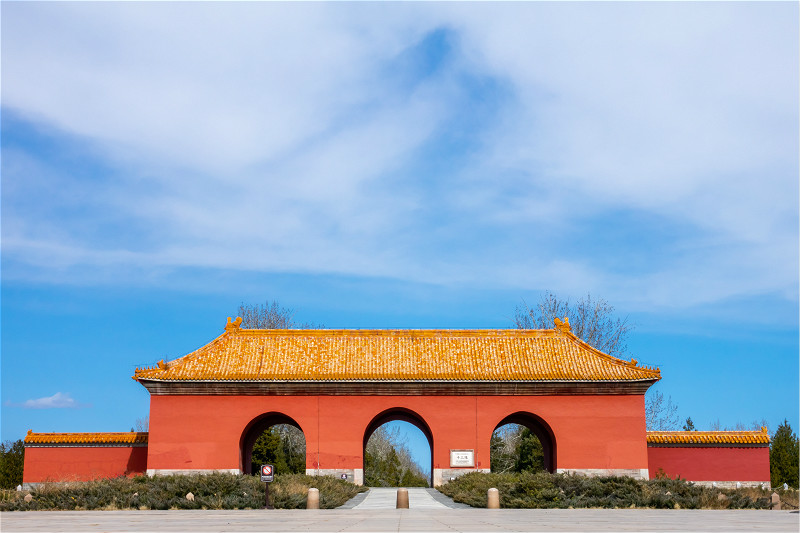Ming Tombs

Ming Tombs [Photo via tuchong.com]
Of the 16 emperors who ruled China during the Ming Dynasty (1368-1644), 13 are buried in a box canyon at the southern foot of Tianshou Shan (hence the Chinese name Shisan Ling, the 13 Tombs). The first emperor of the Ming, Hongwu, is entombed in Xiao Ling, near Nanjing. This is the most extensive burial complex of any Chinese dynasty.
A red gate sealed off the valley, guards were posted, and no one, not even the emperor, could ride a horse on these grounds. The site was chosen by the Emperor Yongle, who also oversaw the construction of the Forbidden City. Protected from the bitter northern winds by a mountain range, the tombs are constructed in a conventional fashion, with memorial halls at the front and burial chambers to the rear. The entrance to the Ming Tombs, a long and celebrated spirit way is lined with statues of guardian animals and officials. Only three of the Ming Tombs, Ding Ling, Chang Ling, and Zhao Ling, have been restored, and only one (Ding Ling) has been fully excavated. Many of the buildings mirror Ming palaces found in the city. Because of this, the sight can be boring to people who've had their fill of imperial architecture.
The Ming Tombs are a collection of mausoleums built by the emperors of the Ming Dynasty of China, collectively known as the Thirteen Tombs of the Ming Dynasty. The sitting of the Ming Dynasty imperial tombs was carefully chosen according to Feng Shui principles. They cover an area of about 120 square kilometers. Only 3 tombs open to public and Changling Tomb is the largest and oldest one while the Dingling Tomb is the only excavated one.
The Ming Tombs are at their most charming along the spirit way and on the grounds of unrestored tombs (free admission). In contrast, the restored tombs are dank, overcrowded, and uninspiring. The Ming Tombs are so unpopular with foreign tourists that they are often excluded from tour-group itineraries. At present, only the Sacred Way, Changling Tomb, Zhaoling Tomb and Dingling Tomb are open to the public.
Featured Attractions:
Dingling Tomb
Dingling, one of the tombs at the Thirteen Tombs of the Ming Dynasty site, is the tomb of the Wanli Emperor, his empress consort and the mother of the Taichang Emperor. It is the only Ming tomb to have been excavated. The burial chamber opens to the public so you can learn about the funeral custom of the imperial family. In addition, a variety of cultural relics are displayed in the hall as well.
Admission Fee:
CNY 60 (April 1 – October 31)
CNY 40 (November 1 – March 31)
Admission Hours:
08:00 – 17:30 (April 1 – October 31)
08:30 – 17:00 (November 1 – March 31)
Changling Tomb
Changling Tomb, the tomb of Emperor Yongle and his empress Xu, is the first of the Thirteen Tombs of the Ming Dynasty. At the largest scale, it covers an area of 120 thousand square meters.
Sacred Way
The Sacred Way, also known as Changling Sacred Way, is the approach to the Changling Tomb. Along the way from south to north, you will see a number of sites of interest and beauty, including the Stone Tablet Archway, Great Red Gate, Tablet Pavilion, Ornamental Columns, Stone Figures, Lingxin Gate. Changling Tomb Walking along the Sacred Way to the end, you can see the Changling Tomb (built in 1409), where lies the third Emperor of the Ming Dynasty, Emperor Zhu Di and his Empress Xu. It is the largest, original and the best preserved among the thirteen tombs, and has three courtyards in the front and a Treasure City in the round rear part. The magnificent Grace and Blessing Palace (Ling'en Palace) in the second courtyard is highly recommended. Dingling Tomb Built from 1584 to 1590, it is the mausoleum of Emperor Zhu Yijun, the thirteenth emperor of the Ming Dynasty and his two empresses. The highlight of this tomb is the stone Underground Palace, which was discovered between 1956 and 1958, and had a great deal of precious relics unearthed. Zhaoling Tomb Located in eastern foot of Dayu Mountain, Zhaoling is where the 12th emperor of the Ming Dynasty, Emperor Zhu Zaihou and his three empresses were buried. It features the special Dumb Yard in a crescent shape housing the imperial coffins.
1. Special Tourist Bus No. 872 (formerly 925) runs directly from Desheng Gate to Dingling and Changling every 30 minutes during peak hours from 07:10-19:10.
2. Take Bus No. 919 branch line 1,345 branch line or 881 at Desheng Gate West Station. Get off at Changping Dongguan Crossing Station, and then take Bus No. 314 to the Sacred Way (Nanxin Village Station), Dingling and Changling.
3. Take Changping Bus No. 22 to Changling, Dingling and Zhaoling at Li Shui Qiao Station, or take Bus No. 345 branch line or 881 at Desheng Gate West Station, get off at Sha He Station, and then transfer to Changping Bus No. 22. Take Subway Line 5 to Tiantongyuan Bei Station, and transfer to Changping Bus No. 22.

